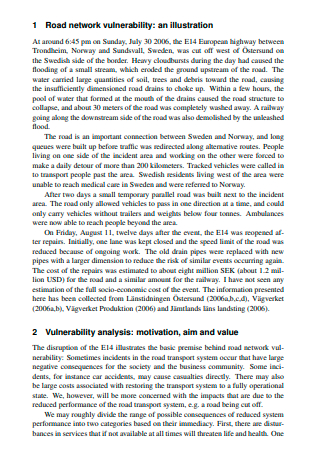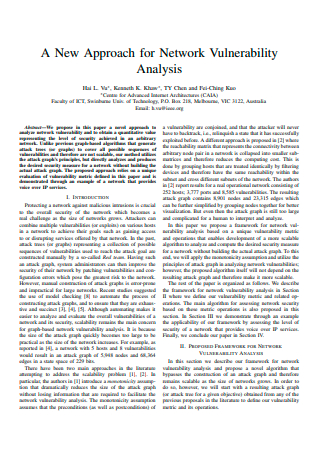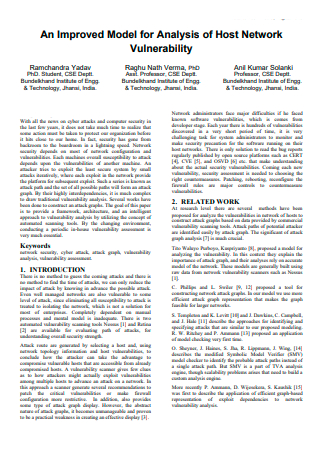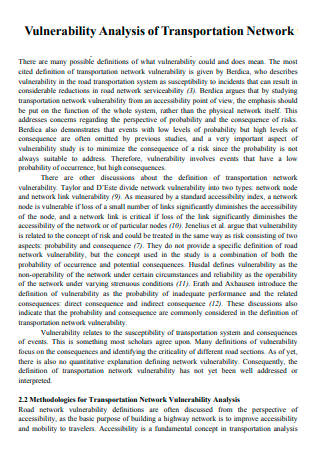8+ Sample Network Vulnerability Analysis
-

Financial Network Vulnerability Analysis
download now -

Road Network Vulnerability Analysis
download now -

Network Vulnerability Analysis in PDF
download now -

Basic Network Vulnerability Analysis
download now -

Host Network Vulnerability Analysis
download now -

Transportation Network Vulnerability Analysis
download now -

Network Traffic Vulnerability Analysis
download now -

Network Vulnerability Analysis Example
download now -

Graph-Based Network Vulnerability Analysis
download now
FREE Network Vulnerability Analysis s to Download
8+ Sample Network Vulnerability Analysis
What Is a Network Vulnerability Analysis?
Benefits of Vulnerability Scanning
How To Conduct a Vulnerability Assessment
FAQs
What is a vulnerability assessment tool?
What is a vulnerability assessment framework?
What Is a Promissory Note and Security Agreement?
What Is a Network Vulnerability Analysis?
A network vulnerability assessment is a survey and analysis of a company’s network infrastructure to identify cybersecurity flaws and network security breaches. The examination can be conducted manually or with software for vulnerability analysis. Software is preferred because it is less prone to human mistakes and produces more reliable results. A vulnerability assessment analyzes the network security of a company. It also identifies security flaws that could affect the network’s general business operations, cybersecurity, and privacy. Do not mix vulnerability assessments with penetration tests (pen tests), which simulate a cyberattack. A penetration test primarily focuses on firewalls and their weaknesses, attempting to gain unauthorized access to your computer systems using phishing emails, malware attacks, and other means to install malware. Consider a network vulnerability assessment as an internal audit that looks for and reports on vulnerabilities in your networks and operating systems. Sixty-two percent of cyberattacks target small organizations because their designs are easier to penetrate, according to research.
Benefits of Vulnerability Scanning
Vulnerability scans are proactive examinations of a system’s health to ensure that it remains in optimal operating condition, analogous to biological studies for individuals. A vulnerability check guarantees that every entry point to a company’s network is updated, turned off, or regularly monitored to prevent cyber criminals from gaining access. Vulnerability scanning detects and classifies potential security exploit points in network devices, applications, computer systems, and data repositories. It examines the attack surfaces in your computer networks, such as firewalls, programs, and services, that internal or external attackers could employ to obtain unauthorized access. Scan results are matched to a database of known vulnerabilities to detect security holes in your network and allow you to remedy them before they become an issue. As a modern digital enterprise, you cannot rely on someone else to alert you to a potential problem before you find out about it yourself. An effective security strategy requires frequently analyzing your systems for vulnerabilities before they become an issue. If you are curious about more, we have compiled a list of the top advantages of vulnerability scanning.
How To Conduct a Vulnerability Assessment
No firm intentionally takes on the risk. Or, even worse, become the focus of the latest cyber-attacks. 60% of breaches in 2019 featured unpatched vulnerabilities, according to a Ponemon Institute survey. Conducting routine network vulnerability assessments is one strategy to mitigate this risk. The following action items, grouped into three major phases, constitute an advanced vulnerability assessment process:
1. Conduct Risk Identification And Analysis
Identifying risks and potential hazards for each asset is a complex undertaking. The most critical aspect of the process is its organization so that nothing crucial falls through the cracks. Companies can add columns for risks and vulnerabilities to their asset registers. Thus, you will have a centralized document including all the required information. After assigning threats and vulnerabilities to your assets, you may begin posting risks by estimating the impact and likelihood of each threat’s materialization. Once complete, you can prioritize holdings with the highest risk rating and those most severely impacted by known weaknesses or vulnerabilities. In practice, most businesses do a broad assessment to identify the most significant risks and control mechanisms, followed by a second, brief evaluation of the threats by the employees ready to begin the job. For further information and assistance with risk assessment, please visit Risk management.
2. Vulnerability Scanning Policies and Procedures
Policies and procedures must exist to have a predetermined course of action that must be followed to have a structured and practical scanning approach. This encompasses every facet of vulnerability scanning. First and foremost, the policy or procedure should have an official owner accountable for everything. Before implementation, the policy should also be authorized by top management. Determining the frequency of scanning is also essential for ensuring compliance. Everything relating to the configuration and functionality of vulnerability scans should be highlighted and documented from a technical standpoint. The document should also contain instructions on what to do once the scan is complete. The most important criteria are the sorts of scans that will be undertaken, how they will be conducted, the software solutions that will be used, the vulnerabilities that will be prioritized, and the procedures that must be followed after the scan has been completed.
3. Identify The Types Of Vulnerability Scans
Vulnerability scanning is identifying security holes in information systems using vulnerability scanning software. Network administrators, information security analysts, and all technical IT workers trained and assigned to conduct a vulnerability scan can execute a scan. Most malevolent hackers seek to map a network by scanning the system for potential vulnerabilities to obtain unauthorized access to information systems. If the hostile hackers you’re attempting to fight against employ vulnerability scanning tools, you must also apply them to remain ahead of them. You must decide the sort of scan to execute based on the software running on the system you need to scan and secure to maximize the benefits.
4. Perform The Scan
After deciding the type of scan you wish to do and configuring the scan’s configuration, you can save the design and run the scan as requested. Completion time can range from minutes to hours depending on the target set’s size and the scan’s intrusiveness. During the scanning phase, the tool you utilize will collect basic information about the specified targets by obtaining their fingerprints. The program will enumerate the marks with this information and contain other specifications, such as running ports and services. After determining the service versions and configuration of each target IP, the network vulnerability scanning program will next proceed to map out any vulnerabilities existing in the targets.
5. Evaluate And Consider Possible Risks
Most of the risks of a vulnerability scan involve whether or not the target system is available. If the traffic load caused by the scan is too much for the links and connections to handle, the remote target could shut down and become unavailable. Extra care should be taken when scanning critical or production systems, and the scan should be done after hours, when there is less traffic to the target, to avoid overloading the system.
6. Interpret The Scan Results
The most important thing is to have capable staff set up, run, and look at the results of a vulnerability scan. Knowing about the scanned system is essential to put remediation efforts in the correct order. Even though each vulnerability scanning tool will automatically set the priority of vulnerabilities, some types of openness should be given more attention. Suppose there is a public exploit for a vulnerability you found in your system. In that case, it should take priority over other vulnerabilities that could be exploited, but it would take a lot more work.
FAQs
What is a vulnerability assessment tool?
The purpose of vulnerability assessment tools is to automatically detect new and current threats that potentially target your application. Web application scanners that test for and mimic known attack patterns are examples of tools. Protocol scanners that look for insecure ports, protocols, and network services.
What is a vulnerability assessment framework?
It allows officers to compile a more comprehensive record of the circumstances and facts that led them to identify a person as vulnerable and in need of aid, arrest, or referral. Officers trained to use this instrument are supposed to identify indicators of vulnerability.
What Is a Promissory Note and Security Agreement?
Multiple documents, including promissory notes and security agreements, always accompany loans from banks or other institutional lenders. Generally, a promissory note is a written commitment to repay a debt, but a security agreement is used when collateral is secured. Notes of credit are debt instruments. They are available through banking institutions. Nonetheless, they can also be issued by small businesses and individuals. They make it possible for a person or a company to acquire finance without a bank.
A vulnerability assessment is a method to find security flaws in a system, measure and analyze them, and fix them based on already determined risks. Reviews are essential to a complete security program and are mentioned in many industry standards and compliance regulations. Hundreds of companies are already using this vulnerability assessment report to plan IT security projects for the remote era.
